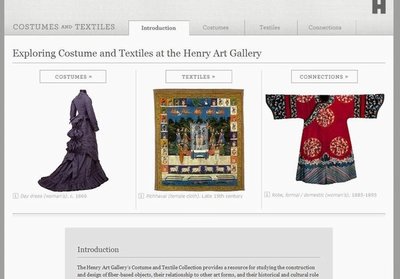October 8, 2009
Online and in depth: The Henry offers new Digital Interactive Galleries
The Henry Art Gallery’s new Digital Interactive Galleries will give the public an unprecedented level of detail and context about some of the museum’s key subcollections. They’re databases and then some — with Google Earth on hand to “fly” users to an item’s point of origin to learn more.
Three interactive galleries are currently planned, and one is already finished and open for public use. That displays items from the Henry’s 18,000-item collection of costumes and textiles. It’s available to anyone anywhere on the Web, and even more detailed access is provided at a computer station in the museum’s lobby. You can visit the Costumes and Textiles online gallery <a href=”http://dig.henryart.org/textiles/”>here</a>.
Coming likely this fall will be two other galleries on themes close to the Henry’s heart. A gallery on Northwest artists will include video and slide shows of contemporary artists in the Henry’s collection. A gallery on photography and new media will feature elements of the Henry’s Joseph and Elaine Monsen Photography Collection as well as a timeline of technical and conceptual innovations in photography.
Items in the Costumes and Textiles galleries are linked with locations on Google Earth, so users can learn about the geographic background of items they’re studying by dramatically swooping across Google’s globe for visits.
The galleries, funded by a two-year 2007 grant from the Institute of Museum and Library Services, are the latest step in a years-long process of annotating and digitizing the Henry’s collections, said Judy Sourakli, the Henry’s curator of collections.
“In 1994 we had our first database but it didn’t allow for images, and since that time we’ve been busy entering data,” Sourakli said. “And then about six years ago we started creating digital images.”
The process set the stage for improvements to come. “We used that time really well. The goal was to end up with basic information — who made it, where it came from and its title — and then do a lot with structure, technique and medium for artworks. And donor credits,” Sourakli said. “And then we have lots of key words you can search that relate to anything from subject to style to period.”
There was also much research and detail work involved, cataloging collection items and resolving discrepancies, “but it’s all coming together,” she said.
Matters of copyright also have come into play in this process. In most cases, artists retain the copyright to the works they create, and most of the Henry’s art comes from donors who don’t have control over that copyright.
So, items in the collection that are copyright-protected will appear with only a small, low-resolution image online — enough for basic research but not enough to violate the copyright. Those items for which the museum has permission to display will bear a larger photo.
But at the in-house computer kiosk, which is open for public use, the access is more unfettered. “At this station you can see everything that we can’t put online because it’s an Intranet,” Sourakli said. This might mean several different views of an item, including signatures, labels or other information that would be of interest to researchers.
The whole idea of the Digital Interactive Galleries, Sourakli said, is to give researchers, artists, designers and the general public better access to the Henry’s collections, “and to reach out to the University community, which is a major thing for us.”
The galleries will be helpful for classes, too. Faculty at the UW and elsewhere can choose a group of objects for their students to study on a field trip, and they will have read about the items before they get to the museum. “This has a potential to make a big impact on undergraduate education,” Sourakli said.
All this raises the question, will greater online access to art reduce people’s interest in coming to the museum to see it in person? Absolutely not, Sourakli said.
“Of course they’ll come, because they’ll be more curious,” she said, adding, “There’s no substitution for seeing art in person. However, not everyone can come here, and not everyone can do research here.”
Sourakli said she thinks all museums have a responsibility to make their collections available to the public, and the Digital Interactive Galleries are an important step toward that goal.
But she can still remember the days of typing up note cards for items in the collection, which were illustrated with small black and white photographs. Then came color, and now digital imaging, and preparation for whatever comes next.
“It’s a moving target, in terms of accessibility,” she said.
Learn more about the Henry Art Gallery and its online collections and galleries, visit www.henryart.org.



